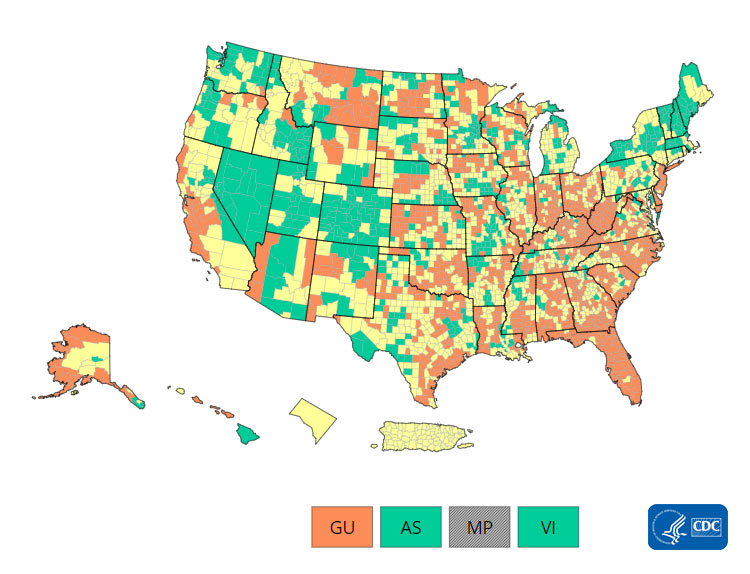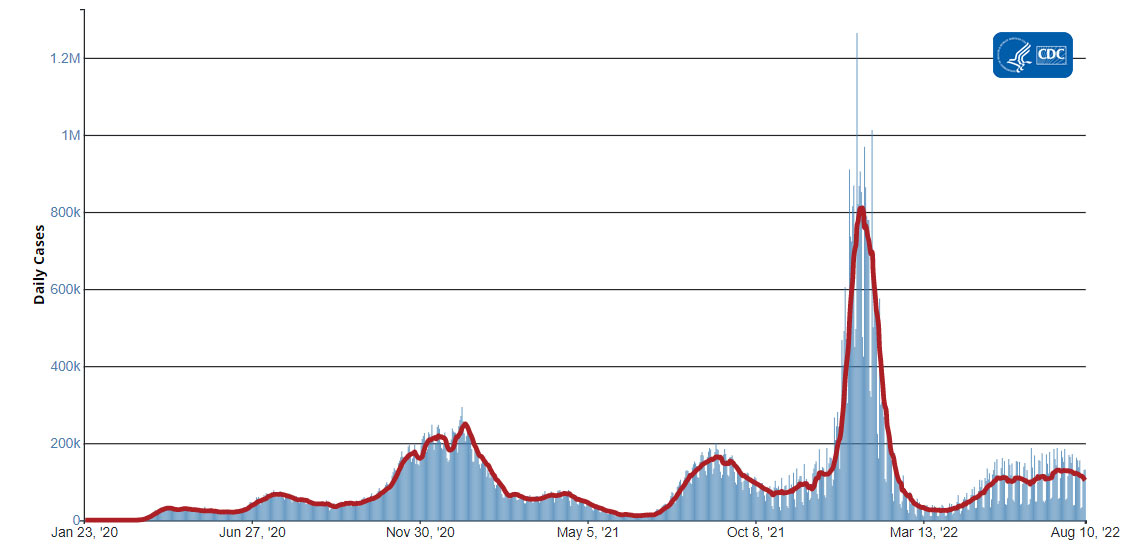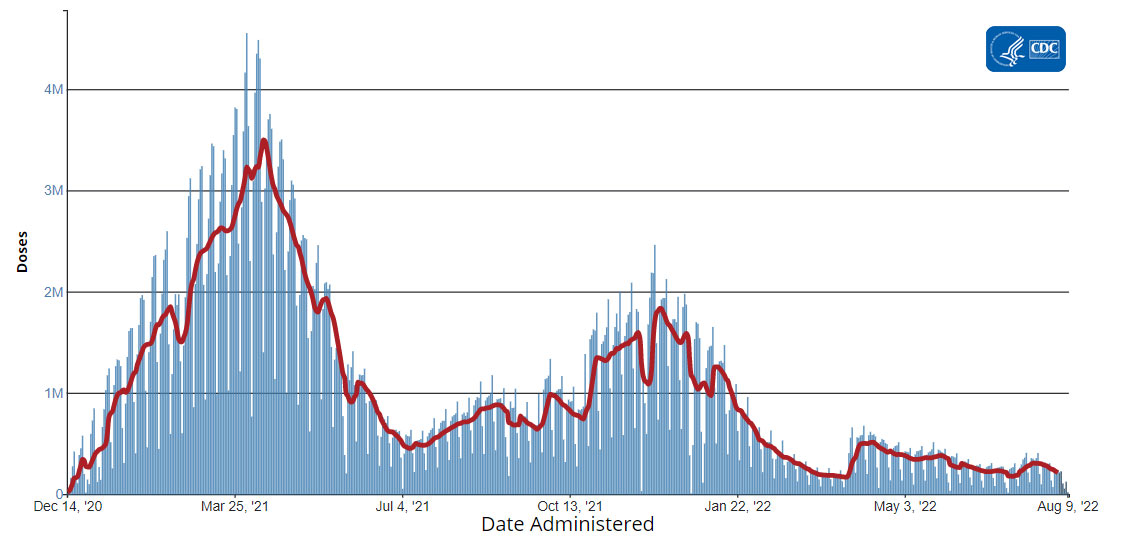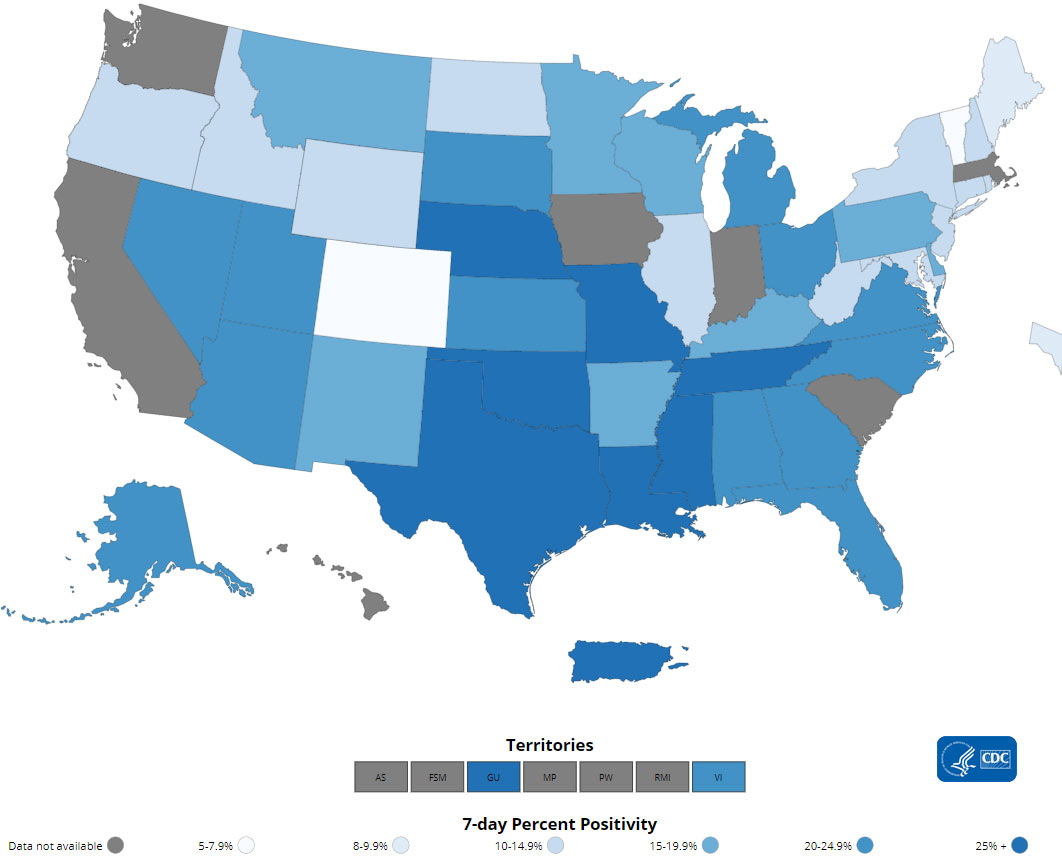Recommendations for Fully Vaccinated People
COVID-19 Homepage
COVID-19 Vaccine Equity
Interpretive Summary for August 12, 2022
COVID-19 Vaccine Equity
COVID-19 has caused more than 1,030,000 deaths in the United States since the start of the pandemic and was the third leading cause of death in 2020 and 2021. Throughout the pandemic, people from racial and ethnic minority groups (Black, Hispanic/Latino, American Indian and Alaskan Native (AI/AN), and Native Hawaiian and Other Pacific Islander (NHOPI)) have been disproportionately affected by death from COVID-19 compared with White people. These inequities have decreased over time, but have not been eliminated.
CDC’s COVID Data Tracker shows that lower proportions of people who are Black, Hispanic/Latino, AI/AN, or NHOPI have received a second booster dose than White and Asian people. There are many factors that create challenges to vaccination access and acceptance, often disproportionately affecting racial and ethnic minority groups. Factors include gaps in education, income and wealth; job access and working conditions; racism and other forms of discrimination; unequal healthcare access and quality; transportation and neighborhood conditions; and lack of trust as a result of past medical racism. Efforts to maintain sufficient up-to-date vaccination must respond to community needs.
COVID-19 vaccines available in the United States are effective at protecting people—especially those who are boosted—from getting seriously ill, being hospitalized, and even dying. Because COVID-19 vaccines are readily available, the nation is closer than ever to ending the COVID-19 pandemic in the United States. Yet challenges remain in ensuring all people have fair and just access to COVID-19 vaccination. CDC is committed to ongoing work to promote vaccine equity. Learn more.
- COVID Data Tracker’s Vaccination Demographics and Vaccination Demographic Trends tabs were updated to display COVID-19 vaccine primary series data for children under age 2 years and between ages 2–4 years.
- COVID-19 Self-Test Data: Challenges and Opportunities — United States, October 31, 2021–June 11, 2022
- Notes from the Field: School-Based and Laboratory-Based Reporting of Positive COVID-19 Test Results Among School-Aged Children — New York, September 11, 2021–April 29, 2022
- Summary of Guidance for Minimizing the Impact of COVID-19 on Individual Persons, Communities, and Health Care Systems — United States, August 2022
COVID-19 Community Levels
As of August 11, 2022, there are 1,275 (39.6%) counties, districts, or territories with a high COVID-19 Community Level, 1,309 (40.7%) counties with a medium Community Level, and 636 (19.8%) counties with a low Community Level. Compared with last week, this represents a small decrease (−2.1 percentage points) in the number of high-level counties, a small increase (+1.8 percentage points) in the number of medium-level counties, and a marginal increase (+0.3 percentage points) in the number of low-level counties. Overall, 51 out of 52 jurisdictions* had high- or medium-level counties this week. Nevada is the only jurisdiction to have all counties at low Community Levels.
To check your COVID-19 Community Level, visit COVID Data Tracker. To learn which prevention measures are recommended based on your COVID-19 Community Level, visit COVID-19 Community Level and COVID-19 Prevention.
*Includes the 50 states, the District of Columbia, and U.S. territories.
Reported Cases
As of August 10, 2022, the current 7-day moving average of daily new cases (103,614) decreased 13.8% compared with the previous 7-day moving average (120,151). A total of 92,426,945 COVID-19 cases have been reported in the United States as of August 10, 2022.
Variant Proportions
CDC Nowcast projections* for the week ending August 13, 2022, estimate that the combined national proportion of lineages designated as Omicron will continue to be 100% with the predominant Omicron lineage being BA.5, projected at 88.8% (95% PI 87.5-90.0%).**
There are several lineages of Omicron and within each are multiple sublineages. The national proportion of BA.4 is projected to be 5.3% (95% PI 4.9-5.7%), BA.4.6 is projected to be 5.1% (95% PI 4.1-6.4%), and BA.2.12.1 is projected to be 0.8% (95% PI 0.7-0.9%). See COVID Data Tracker for current data.
92,426,945
Total Cases Reported
92,426,945
Total Cases Reported
103,614
Current 7-Day Average***
103,614
Current 7-Day Average***
120,151
Prior 7-Day Average
120,151
Prior 7-Day Average
-13.8%
Change in 7-Day Average since Prior Week
-13.8%
Change in 7-Day Average since Prior Week
*The median time from specimen collection to sequence data reporting is about 3 weeks. As a result, weighted estimates for the most recent few weeks may be unstable or unavailable. CDC’s Nowcast is a data projection tool that helps fill this gap by generating timely estimates of variant proportions for variants that are circulating in the United States. View Nowcast estimates on CDC’s COVID Data Tracker website on the Variant Proportions page.
**Please note, there were two public variant proportions data updates this week on the COVID Data Tracker on Tuesday, 8/9/2022 and Friday, 8/12/2022. These data will update on Fridays going forward.
***Historical cases are excluded from daily new cases and 7-day average calculations until they are incorporated into the dataset for the applicable date. Of 653,836 historical cases reported retroactively, 1,024 were reported in the current week and 92,150 were reported in the prior week.
Vaccinations
As of August 10, 2022, 606.2 million vaccine doses have been administered in the United States. Overall, about 262.0 million people, or 78.9% of the total U.S. population, have received at least one dose of vaccine. About 223.5 million people, or 67.3% of the total U.S. population, have been fully vaccinated.* Of those fully vaccinated, about 107.9 million people have received a booster dose,** but 50.0% of the total booster-eligible population has not yet received a booster dose.
CDC’s COVID Data Tracker also displays vaccination trends by age group and race/ethnicity, disability status, and urban/rural status.
606,162,842
Vaccine Doses Administered
606,162,842
Vaccine Doses Administered
261,981,618
People who received at least one dose
261,981,618
People who received at least one dose
223,457,170
People who are fully vaccinated*
223,457,170
People who are fully vaccinated*
+0.1
Percentage point increase from last week
+0.1
Percentage point increase from last week
+0.1
Percentage point change from last week
+0.1
Percentage point change from last week
+0.0
Percentage point increase from last week
+0.0
Percentage point increase from last week
+0.0
Percentage point change from last week
+0.0
Percentage point change from last week
*Represents the number of people who have received the second dose in a two-dose COVID-19 vaccine series (such as the Pfizer-BioNTech, Moderna, or Novavax vaccines) or one dose of the single-shot Johnson & Johnson’s Janssen vaccine.
**Represents the number of people who are fully vaccinated and have received another dose of COVID-19 vaccine since August 13, 2021. This includes people who received their first additional dose or booster dose.
Hospitalizations
New Hospital Admissions
The current 7-day daily average for August 3–9, 2022, was 6,003. This is a 2.6% decrease from the prior 7-day average (6,163) from July 27–August 2, 2022.
5,121,322
Total New Admissions
5,121,322
Total New Admissions
6,003
Current 7-Day Average
6,003
Current 7-Day Average
6,163
Prior 7-Day Average
6,163
Prior 7-Day Average
-2.6%
Change in 7-Day Average
-2.6%
Change in 7-Day Average
The start of consistent reporting of hospital admissions data was August 1, 2020.
Daily Trends in Number of New COVID-19 Hospital Admissions in the United States
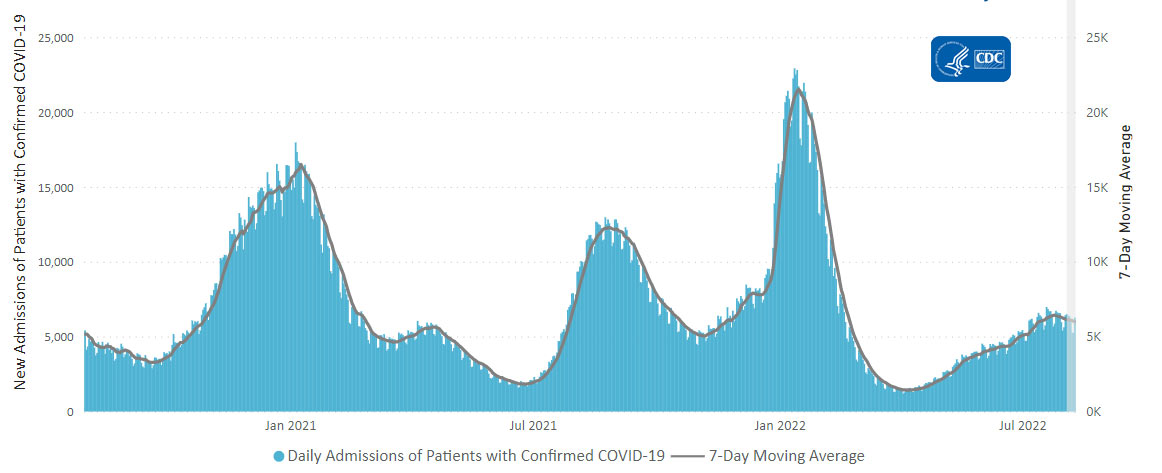
New admissions are pulled from a 10 am EDT snapshot of the HHS Unified Hospital Data – Analytic Dataset. Due to potential reporting delays, data from the most recent 7 days, as noted in the figure above with the grey bar, should be interpreted with caution. Small shifts in historic data may also occur due to changes in the Centers for Medicare & Medicaid Services (CMS) Provider of Services file, which is used to identify the cohort of included hospitals.
COVID-NET: Hospitalization Rates by Vaccination Status among Adults Ages ≥50 Years
CDC’s Coronavirus Disease 2019-Associated Hospitalization Surveillance Network (COVID-NET) shows that monthly rates of COVID-19-associated hospitalizations in June 2022 among adults ages 50 years and older were higher in unvaccinated adults compared to those who received a primary COVID-19 vaccination series plus two boosters or additional doses. Among adults ages 50–64 years, the COVID-19-associated hospitalization rate in June among unvaccinated adults was 3.6 times as high as the rate among those who received a primary series plus two boosters or additional doses. Among adults ages 65 years and older, the rate of COVID-19-associated hospitalizations among unvaccinated adults was 6.3 times as high as the rate among adults who received a primary series plus two boosters or additional doses.
Hospitalization Rates by Vaccination Status among Adults Ages ≥65 Years
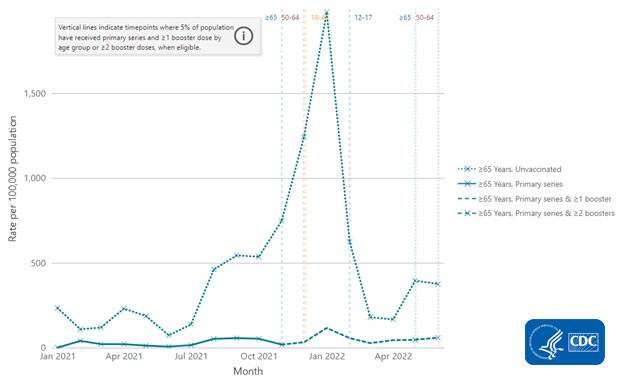
The Coronavirus Disease 2019 (COVID-19)-Associated Hospitalization Surveillance Network (COVID-NET) is an additional source for hospitalization data collected through a network of more than 250 acute-care hospitals in 14 states (representing ~10% of the U.S. population). Detailed data on patient demographics, including race/ethnicity, underlying medical conditions, medical interventions, and clinical outcomes, are collected using a standardized case reporting form.
Deaths
The current 7-day moving average of new deaths (400) has decreased 6.7% compared with the previous 7-day moving average (429). As of August 10, 2022, a total of 1,030,777 COVID-19 deaths have been reported in the United States.
1,030,777
Total Deaths Reported
1,030,777
Total Deaths Reported
400
Current 7-Day Average*
400
Current 7-Day Average*
429
Prior 7-Day Average
429
Prior 7-Day Average
-6.7%
Change in 7-Day Average Since Prior Week
-6.7%
Change in 7-Day Average Since Prior Week
*Historical deaths are excluded from the daily new deaths and 7-day average calculations until they are incorporated into the dataset by their applicable date. Of 21,756 historical deaths reported retroactively, none were reported in the current week; and none were reported in the prior week.
Daily Trends in Number of COVID-19 Deaths in the United States Reported to CDC

7-Day moving average
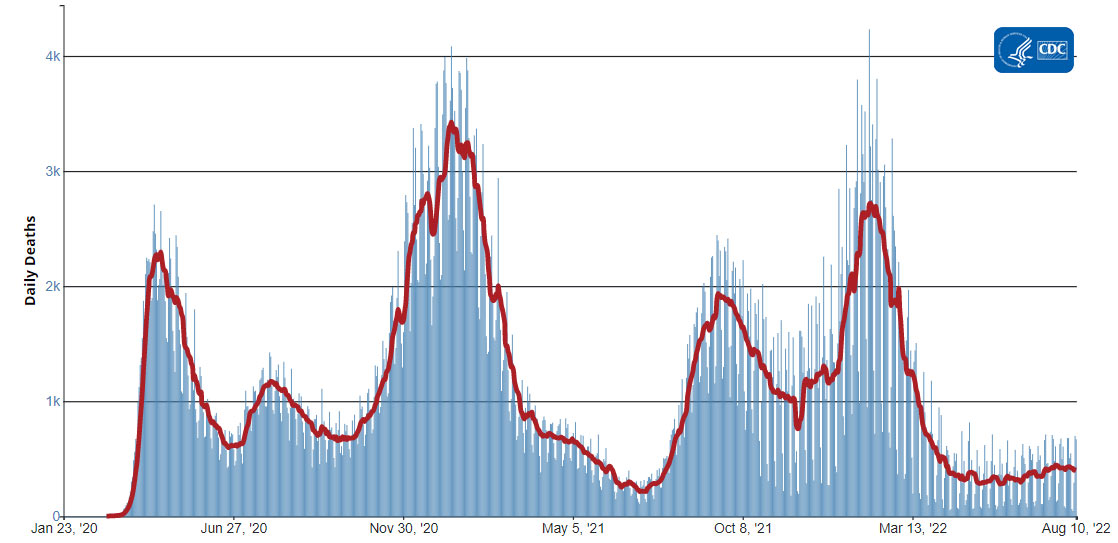 More Death Data
More Death DataTesting
The percentage of COVID-19 NAATs (nucleic acid amplification tests)* that are positive (percent positivity) is decreasing in comparison to the previous week. The 7-day average of percent positivity from NAATs is now 16.8%. The 7-day average number of tests reported for July 29–August 4, 2022, was 547,772, up 3.0% from 531,591 for the prior 7 days.
936,519,725
Total Tests Reported
936,519,725
Total Tests Reported
547,772
7-Day Average Tests Reported
547,772
7-Day Average Tests Reported
16.8%
7-Day Average % Positivity
16.8%
7-Day Average % Positivity
17.6%
Previous 7-Day Average % Positivity
17.6%
Previous 7-Day Average % Positivity
-0.80
Percentage point change in 7-Day Average % Positivity since Prior Week
-0.80
Percentage point change in 7-Day Average % Positivity since Prior Week
*Test for SARS-CoV-2, the virus that causes COVID-19
Wastewater Surveillance
COVID Data Tracker’s Wastewater Surveillance tab tracks levels, changes, and detections of SARS-CoV-2* viral RNA in wastewater at over 1,000 testing sites across the country.
Currently, most of the country is reporting moderate to high SARS-CoV-2 levels in wastewater. About half of sites reporting wastewater data are currently seeing some of the highest levels for those sites since December 1, 2021. About half of sites are experiencing a decrease in SARS-CoV-2 levels, and about 41% are reporting an increase. It’s important to note that even a small increase when levels are low can appear like a dramatic increase in the percent change.
For more information on how to use wastewater data visit CDC’s website.
*The virus that causes COVID-19
SARS-CoV-2 Levels in Wastewater by Site


0% means levels are the lowest they have been at the site; 100% means levels are the highest they have been at the site.


